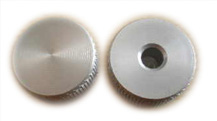 |
 |
 |
 |
 |
 |
 |
 |
 |
 |
 |
 |
| click any Photo for detailed views |
|
Reviews: Below stories of restoration, repair or rebuild of the Ferrograph Logic 7, with notes on final outcome. My first Logic 7 I got was secondhand, and had some modifications made direct before, or a little after the first time sold. Anyway, the machine went in without any cosmetic damage e.g. scratches, physical damage etc. Although the machine lit up, it didn't work at all. Investigation found some errors, which resulted in a full restoration being required. Opening all front-covers, I find this machine was built like a RR, but also a gentle generation, since all electrical parts where mount on epoxy plates and not the older paxolin mounts. Also all big caps and resistors where covered with plastic heads against electrical shock... never notice this with any Ferrograph machine before. The handwiring is clean and exactly as depicted in the Maintenance Manual. I replaced all rubber-wheels with former rebuilt ones. It appeared that this machine hadn't been opened before. What luck, it meant that the recorder did not any faults caused by previous owners trying to fix any problems. Which made it easier to get the machine fixed and running again. Some knobs needs reconstructed, since it was almost impossible to get any spare parts. So knobs were made to match the original style and build quality, the recorder has all knobs in place without and now matches the original model. Locking for spares for my Logic 7, I was able to get hold of a damaged Ferrograph Logic, Dolby Version. After a brief inspection I was going to take this machine apart, since it was hopeless to get it back to work into real world. After some days off and a deeper look into, I find this machine needs to run some more years. What to do:
Thanks to George West, www.ferrograph.info with helping hands and hints regards how to rebuild knobs, here are first methods to do so: Order all the knobs you need eg. in Great Britain. For the big knob I get the all Aluminium Knob: Jackson Bros 5608, Tap M3 (6.35mm), Diameter 25.4 mm, Depth 12.3mm A CNC machine or little handcraft with hobby-drills will do the rest. I use this big knob for all the other little knobs too, since this knob is full Aluminium and easy to work with. Tools are 3 edge Diamond-File, Steel-Saw and for finals, fine grain Diamond Sand-Paper. Machines used in first place was a CNC, but after the first result, I finally using a good hand-drill machine with speed-adjustment. 
I uses M3 shaft fits into drilling-machine and mount the knob onto the shaft, using saw to cut down the knobs to needed hight and use the file to build a little step-down at bottom, like original. Using the 3 edge Diamond file to cut down the edges as find in original place. Finally I used fine Diamond-paper to get the shinny top view and polished all over. For the little knobs I spin down the big knob with bigger Diamond-file to the needed diameter. Rewiring all 3 stereo-pots like original made, thanks to the original Maintenance Manual I got and restore all needed wires to get the winding motors back to work as designed in first place, the machine starts up to work like a Logic 7 use to. Some measure shows total dis-adjust to all recording and playback adjustments. Restore all settings to original pre-sets, I was able to record and playback with this Logic 7 Dolby machine for the first time again. The Ferrograph Super Seven was send in a box as puzzle. I never notice, how much and non-professional a Ferrograph Reel to Reel Tape recorder can taken apart. When I first open the box, I was closing it up again and like to use this mess as spare parts for Logic 7, since most parts fit for Logic 7 too. I open the box some time later again for a deeper view. I find a little metal-box with hundreds of nuts and screws, shafts, knobs and more. Counting and sorting shows almost all parts still there. There where also three motors, capstan and adjustments but also dismantled. Idlers and record head was there and I find all needed little adjustment screws for it later. Since all newer Ferrograph machines built in three main parts, I was able to get all parts back in place. Some testing and a little pre-adjustment, all three parts married again and for the first time after a long time period apart, the Super Seven starts to look like a tape recorder again. Some time consumption and freckle work needed to adjust the winding and capstan motors. At last this machine needed an all-over mechanical re-adjustment for getting all parts back into work. Also electrical adjustment was done, since some parts where formally replaced with spare parts, eg. some of the left parts are not original, but newer. Finally the three covers where mechanical adjusted, since packing and transport bent some of the parts, but this machines are build like a tank and thanks for this, the Ferrograph Super Seven is back into real life and running fine. |
(c) 2007-2008 U.W.E.